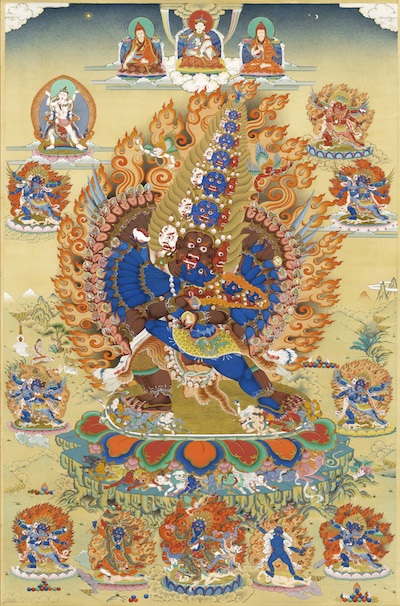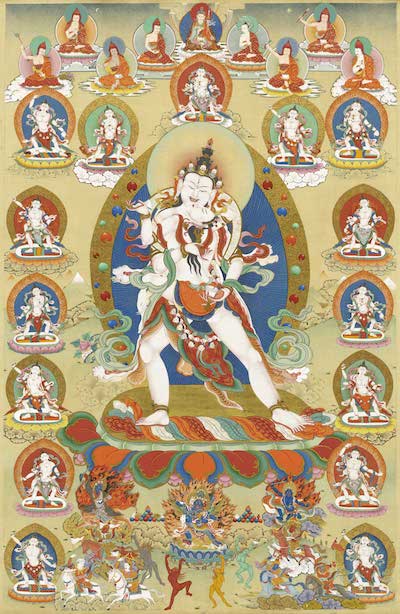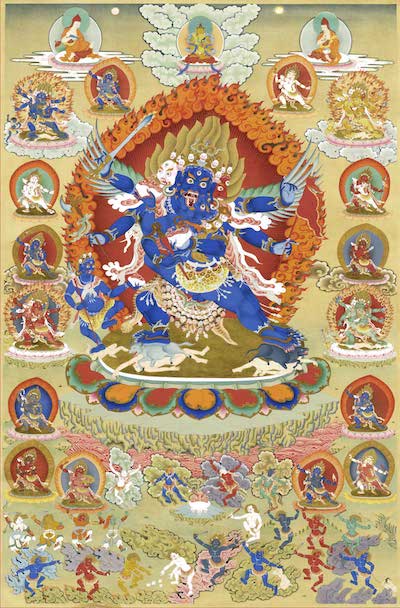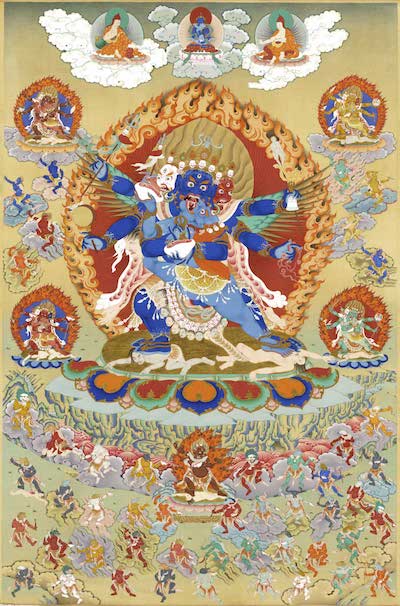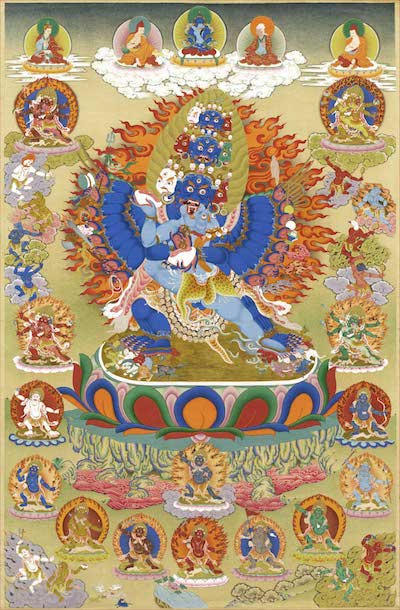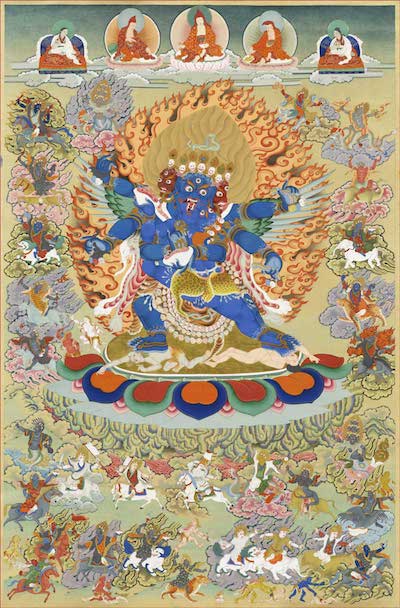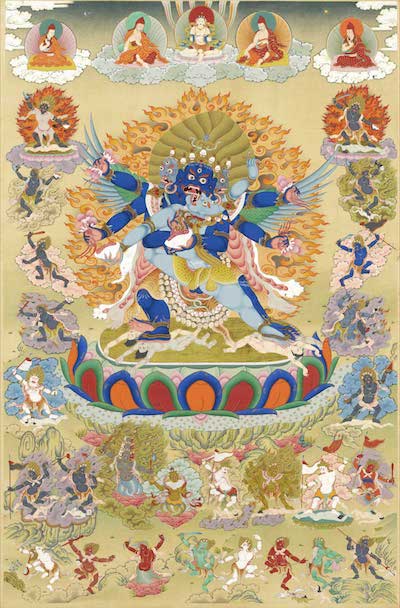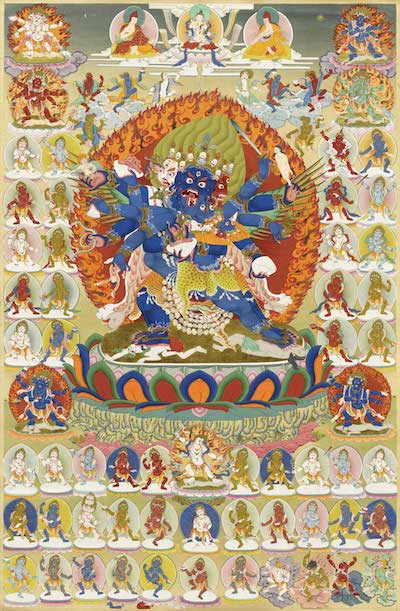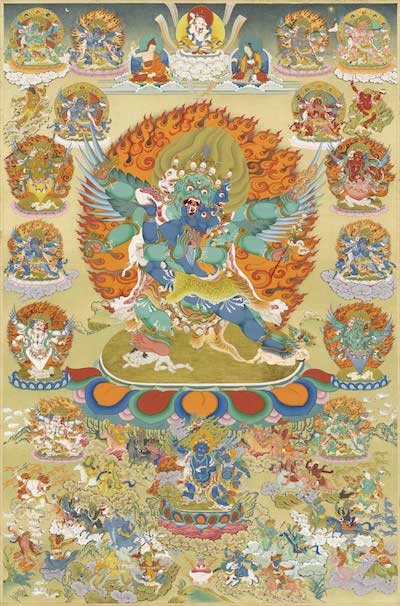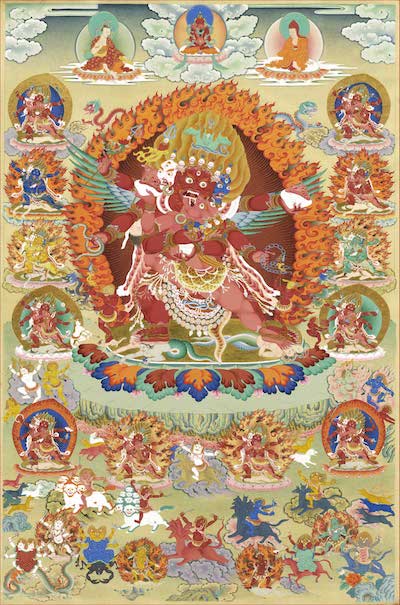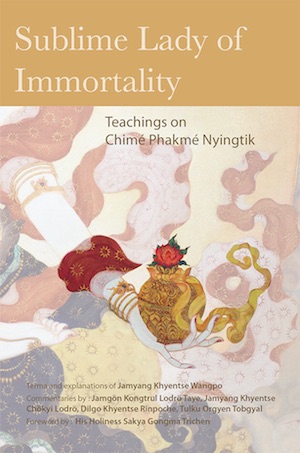25 September 2012
Orgyen Tobgyal Rinpoche is, and always has been, a great patron of the Buddhist arts. Of course, these days, it’s become fashionable either to invest large sums of money in antique, historical artefacts, or to use new technologies to reproduce many images and statues quickly and in large quantities. In spite of both these trends, Rinpoche himself continues to follow in the footsteps of the great lamas of the past, by employing the best artists and craftspeople he can find, then guiding their work based on his own deep knowledge and experience of the teachings.
In the following transcript, Rinpoche talks about a series of ten thangkas based on the Kagyé teachings, which he personally commissioned and guided to completion. It was the first time this set of Kagyé thangkas had ever been painted.
Currently, Rinpoche is guiding the production of 108 thangkhas, each depicting one of the great of the Dzogchen lineage. Click here for more information.
These thangkas were created to support practitioners of the Mandala of the Eight Great Deities: The Assembly of Sugatas (Kagyé Deshek Düpa) that bring together the essence of all tantras, compendiums and pith instructions.
The ‘eight sadhana teachings’ are:
- Jampel Ku (Yamantaka, enlightened body);
- Padma Sung (Hayagriva, lotus speech);
- Yangdak Tuk (Yangdak Heruka, enlightened mind);
- Dudtsi Yonten (Amritakundali, enlightened qualities);
- Purba Trinlé (Vajrakilaya, enlightened activity);
- Jikten Chötö (mundane worship);
- Möpa Drangak (maledictory fierce mantra);
- Mamo Bötong (Mamo, calling and dispatching)
There is a thangka for each of them in this set, plus a thangka for their main deity, the Lama Rigdzin. In all nine thangkas of the Nine Glorious Ones, the main deity is surrounded by its entire retinue and specific protectors. The tenth thangka is a samaya-support of the self-visualization for the elaborate kyérim and dzogrim practices of Chemchok Heruka, with Chemchok Heruka as the main deity, surrounded only by the other main Kagyé deities. So there are ten thangkas in this set.
The Kagyé are the main yidam deities practised by Guru Rinpoche Padmasambhava, and the path the vidyadharas of the Nyingma school followed; therefore it should be the focus of practice for all Nyingmapas.
As they are so important, I started to wonder if anyone had ever made an accurate set of thangkas representing all the Kagyé deities. I searched high and low throughout India and Tibet, asking everyone I know for guidance, but despite all my efforts, I could not find what I was looking for.
Then I heard of a very sacred and blessed thangka belonging to one of the Nyingma monasteries of Dergé that was said to depict all 725 deities of the Kagyé. Eventually, using every means at my disposal, I managed to see a copy, only to discover that although the main deities appear, the retinue simply show their main manifestations in the four families, while only a few of the lineage masters and protectors have been included.
In the meantime, I came across a book of photos of artefacts in the great Potala palace of the Land of Snows, the land of the Dharma, in which I found images of some of the Kagyé deities, namely Jampel Ku, Pema Sung, Yangdak Tuk, Dudtsi Yönten, Jikten Chötö, Mamo Bötong and Möpa Drangak, accompanied by their entire retinues. Overjoyed at having discovered these authentic representations, I felt confident that I could now make an accurate new set of thangkas.
The only problem was that the book didn’t include images of Phurba Trinlé and Lama Rigdzin, and so I had to rely on other authentic sources to make these two thangkas, basing the design on terma texts and writings of great masters, to the best of my ability.
I also found that the colours, hand implements, and other details in the Potala photos to be different from those mentioned in the The Eight Great Deities: Assembly of Sugatas (Kagyé Deshek Düpa) texts, but as the thangkas in the photos were made according to the Self-arisen Eight Great Deities (Kagyé Rangshar) of the Northern Treasure Cycle, or another very reliable source, there is no doubt they are correct. So, I have based this new set of Kagyé thangkas on Nyangrel Rinpoche’s Kagyé Deshek Düpa tradition, which is one of the three great great Kagyé cycles.
I also examined the detailed description of the pure aspects of the 725 deities that practitioners must remember that can be found in the elaborate practice of Assembly of Sugatas and Jamgön Mipham’s Explanation of the Eight Great Deities (Kagyé Namshé). When I compared them with the Great Meditational Instruction Manual of the Assembly of Sugatas terma (volume nine), I found minor differences and resolved any conflicts by following the descriptions in the Great Meditational Instruction Manual. The representations of the deities were therefore produced without any mistakes being introduced.
I also found that the Great Meditational Instruction Manual only mentions the names of the protectors and does not provide details about their heads, hands, and so on. And so for details of those protectors that did not appear clearly in the photos from the Potala, I referred to Jamyang Khyentsé Wanpo’s empowerment cards for the great Kagyé empowerment, which I have.
Each image in these new thangkas has been based on sources that I examined in minute detail, and I think practitioners can be confident they are correct.
The Thangka Painters
To be able to make samaya drawings of a deity’s physical appearance, the most excellent kind of artist will have received the empowerments and maintained the samayas. At the very least, the artist must have received the specific blessings for painters. To find such a person has proved extremely difficult, so I commissioned artists who have faith in Guru Rinpoche, no wrong views about the Nyingma teachings, and a vast compassionate attitude. The thangka painter Kalzang Dorje, who was born in Eastern region of Kham, was the main artist. Shonu Dondrup Dorje of Dergé, Tashi Dorje of Denma, Tashi Dorje of Dergé, Sonam Puntsok, and Sonam Palden assisted him. It took more than three years for the hands of these artists to bring these ten thangkas into being.
It was an arduous business, but one I undertook because I know from experience that when beginners start to practise the generation phase they need a visual support, as do students new to Kagyé practice. And although there are many thangkas of the main Kagyé deities, thangkas that depict the main deities together with their entire retinue are extremely rare. So, I oversaw the creation of such thangkas because they will be of great benefit to practitioners. I also always kept in mind how easy it is these days to make reproductions, and would like to offer sets to various Nyingma monasteries.
In the presence of many noble beings—for example: the supreme refuge and object of offering for men and gods as perfect as the bodhi tree, the omniscient Rabsel Dawa, or Trulshik Chökyi Lodrö—I have received the empowerments for the three Kagyés, as well as a great number of other elaborate, medium, and concise empowerments. I may not really practise or benefit others by teaching or propagating the Dharma, but I do have the three kinds of faith for the teachings in general, and in particular for the precious teachings of the three inner yoga tantras. As a result, my mind stream has ripened a little, and I, the so-called ‘tulku’, Orgyen Tobgyal, have created these thangkas with a very pure mind and through great effort, bringing together the necessary investment and the required work, so that I may enjoy throughout all my lives, a connection with the supreme yidam deities of The Eight Great Deities: Assembly of Sugatas.
I wrote this in the Tibetan year of the water dragon, in the month when the purvabhadrapada constellation rises with the full moon, on the tenth day of its waxing moon, a most excellent holy day, 25 September 2012.
May virtue increase!
Translated by Gyurmé Avertin
Edited by Janine Schultz
